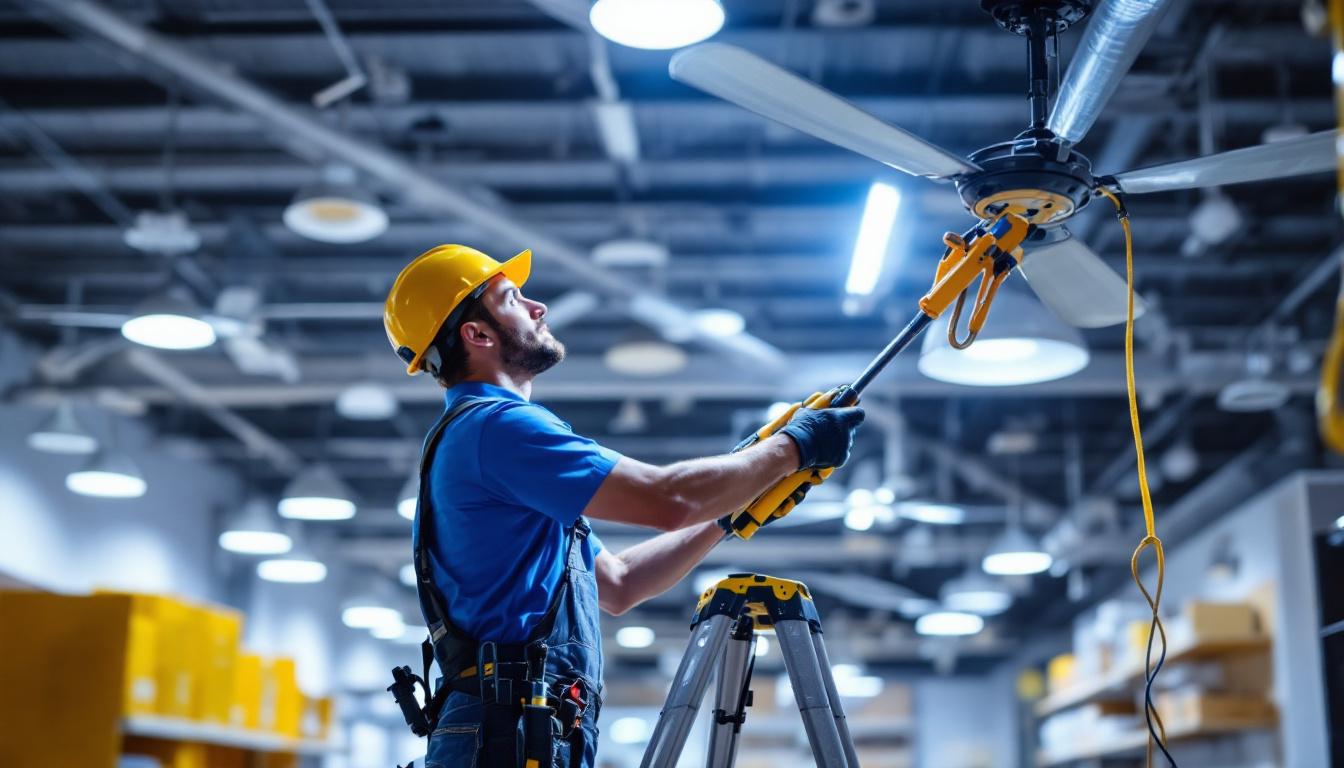
When outfitting retail shops and commercial spaces, lighting contractors often focus primarily on illumination quality, energy efficiency, and aesthetic appeal. However, integrating ceiling fans into these environments is equally critical for maintaining comfort, improving air circulation, and enhancing the overall shopping experience. Fans can help regulate temperature, reduce HVAC costs, and even influence customer behavior by creating a more inviting atmosphere. The strategic placement of fans can also complement the lighting design, drawing attention to specific areas or products, thereby enhancing the visual merchandising strategy.
Despite their importance, fans are sometimes treated as an afterthought or a simple add-on in lighting projects. This oversight can lead to a series of common mistakes that affect both functionality and client satisfaction. For lighting contractors, understanding these pitfalls is essential to delivering comprehensive solutions that meet client expectations while adhering to technical standards. Moreover, selecting the right type of fan—whether it be a sleek modern design or a more traditional style—can significantly impact the overall aesthetic of the space. It’s important to consider factors such as blade size, motor efficiency, and noise levels, as these elements can either enhance or detract from the customer experience.
Additionally, the integration of smart technology into ceiling fans is becoming increasingly popular in commercial settings. Smart fans can be programmed to adjust their speed based on the time of day or occupancy levels, providing optimal comfort while maximizing energy savings. This not only appeals to environmentally conscious consumers but also aligns with the growing trend of automation in commercial spaces. By incorporating these advanced features, lighting contractors can offer their clients a more innovative and adaptable solution that meets the demands of modern retail environments.
“`html
One of the most frequent errors contractors make is failing to accurately calculate the electrical load when adding fans to a lighting circuit. Fans, especially those with integrated lighting kits, can draw significant power. Overloading circuits can cause breakers to trip, create fire hazards, or damage equipment.
Ensuring that the electrical infrastructure supports the combined load of lighting fixtures and fans is crucial. This involves verifying circuit ratings, wire gauge, and breaker capacity. Additionally, compatibility between fan controls and lighting dimmers or switches must be checked to prevent operational issues.
Moreover, contractors should consider the potential for future upgrades or additional installations. Anticipating the need for more fans or enhanced lighting can help in designing a more robust electrical system from the outset. By planning for scalability, contractors can avoid costly modifications later on, ensuring a smoother installation process and long-term functionality.
Ceiling height and fan size are critical factors that influence the effectiveness and safety of fan installations. Installing a fan that is too large for a low ceiling can create discomfort or even pose safety risks, while a fan that is too small for a high ceiling may fail to provide adequate airflow.
Contractors should carefully assess the dimensions of the retail space and select fans with appropriate blade spans and mounting options. Downrod lengths, blade pitch, and motor power should be tailored to the environment to optimize air movement without compromising aesthetics or functionality.
Additionally, the choice of fan design can significantly impact the overall ambiance of the space. For instance, a sleek, modern fan may complement a contemporary retail environment, while a rustic fan might enhance a more traditional setting. Understanding the design language of the space can help contractors choose fans that not only fit physically but also enhance the visual appeal of the area.
Fans are designed to enhance air circulation, but improper placement or orientation can lead to stagnant zones or uneven airflow. Lighting contractors who do not collaborate with HVAC professionals or neglect to study airflow patterns risk creating uncomfortable environments that detract from the shopping experience.
Understanding how fans interact with existing ventilation systems is vital. For example, positioning fans near air conditioning vents or heating units can either amplify or counteract airflow, depending on the setup. Strategic placement ensures that fans complement rather than conflict with the building’s climate control systems.
Furthermore, considering seasonal changes can also influence fan placement and operation. For instance, in warmer months, fans may need to be set to rotate counterclockwise to create a cooling breeze, while in colder months, a clockwise rotation can help circulate warm air. Educating clients on these operational adjustments can enhance comfort and energy efficiency throughout the year.
Lighting contractors often work alongside electricians, HVAC technicians, and interior designers. A common mistake is failing to coordinate fan installations with these trades, leading to conflicts in wiring, mounting, or design aesthetics.
Effective communication and planning can prevent rework and delays. For instance, confirming wiring routes with electricians or discussing mounting locations with designers ensures that fans are seamlessly integrated into the overall project plan. Early collaboration also helps identify potential challenges before installation begins.
In addition, involving all relevant trades in the early design phase can foster a sense of teamwork and shared vision. Regular meetings and updates can help everyone stay aligned on project goals, timelines, and responsibilities. This proactive approach not only streamlines the installation process but also enhances the quality of the final outcome, leading to a more successful project overall.
“`
Retail shops vary widely in size, layout, and design, and the choice of fan must reflect these differences. Contractors should consider options such as ceiling fans, wall-mounted fans, or industrial-grade fans depending on the space and usage.
Ceiling fans with integrated LED lighting offer dual functionality, reducing the need for separate fixtures and simplifying wiring. However, these units must be selected carefully to ensure that lighting quality meets retail standards and that the fan’s airflow capacity suits the environment. In larger retail spaces, high-velocity ceiling fans can provide the necessary air circulation to keep customers comfortable, especially during peak shopping hours. Additionally, wall-mounted fans can be strategically placed to target specific areas, such as checkout lines or product displays, enhancing the shopping experience by maintaining a pleasant temperature.
Energy consumption is a top concern for commercial clients. Fans equipped with energy-efficient motors and variable speed controls can significantly reduce operational costs. Lighting contractors should specify fans compatible with smart control systems, allowing for automated adjustments based on occupancy or time of day.
Integrating fans into building management systems (BMS) or using wireless controls can enhance energy savings and improve user convenience. This approach aligns with growing trends toward sustainable building practices and can be a strong selling point for clients. Moreover, the ability to monitor fan performance through smart technology can provide valuable data for optimizing energy use and predicting maintenance needs. Retailers can also benefit from seasonal adjustments, ensuring that airflow is maximized during high-traffic periods and minimized during quieter times, ultimately leading to a more efficient operation.
Adhering to local building codes and safety regulations is non-negotiable. Contractors must ensure that fan installations comply with requirements related to clearance from walls and fixtures, wiring standards, and fire safety.
Failing to meet these standards can result in costly penalties, project delays, or unsafe conditions. Staying updated on code changes and consulting authoritative resources or inspectors during the planning phase helps mitigate these risks. Additionally, it is essential to consider the long-term implications of fan placement and operation, as improper installation can lead to increased wear and tear, potentially compromising both safety and efficiency. Engaging with local authorities early in the design process can facilitate smoother approvals and ensure that all installations not only meet but exceed safety expectations, fostering a secure environment for both employees and customers alike.
Before specifying fans, contractors should perform detailed site assessments, including measuring ceiling heights, evaluating existing electrical infrastructure, and analyzing airflow patterns. This groundwork informs appropriate product selection and installation strategies.
Using tools such as airflow meters or thermal imaging can provide valuable data, ensuring that fan placement and specifications align with the unique characteristics of each retail space.
Successful fan integration requires a multidisciplinary approach. Lighting contractors should establish clear communication channels with electricians, HVAC professionals, interior designers, and clients. Regular coordination meetings and shared documentation help align expectations and technical requirements.
This collaboration fosters proactive problem-solving and reduces the likelihood of costly errors or rework during installation.
Staying informed about the latest fan technologies, installation techniques, and industry standards empowers contractors to make informed decisions. Manufacturers often provide training sessions and technical resources that can enhance contractor expertise.
Understanding product warranties, maintenance needs, and troubleshooting procedures also equips contractors to provide superior service and support to clients.
Using reputable fan brands and ensuring professional installation practices are essential to project success. Quality products offer better performance, durability, and energy efficiency, while skilled installation minimizes the risk of operational issues.
Contractors should verify that installation teams follow manufacturer guidelines and safety protocols, and conduct thorough testing before project handover.
Fans play a pivotal role in creating comfortable, energy-efficient, and visually appealing retail environments. For lighting contractors, avoiding common mistakes in fan specification and installation is key to delivering comprehensive solutions that satisfy client needs and enhance the shopping experience.
By focusing on accurate load calculations, appropriate fan sizing, airflow optimization, cross-trade collaboration, and adherence to codes, contractors can elevate their projects and build lasting client relationships. Continuous learning and attention to detail ensure that fans are not merely functional add-ons but integral components of successful commercial lighting designs.
“`html
Ready to avoid the common pitfalls in fan integration and enhance your lighting projects? Choose LumenWholesale for your lighting and fan needs. Our extensive selection of spec-grade products ensures you have access to the highest quality fans and lighting solutions at unbeatable wholesale prices. With LumenWholesale, you can trust that you’re getting reliable, high-performance products for your retail environments without the inflated markups. Plus, with the convenience of free shipping on bulk orders, you can save even more while getting your products delivered directly to you. Elevate your commercial lighting designs with the perfect blend of quality, affordability, and convenience. Wholesale Lighting at the Best Value is just a click away.
“`

Discover why purchasing high bay occupancy sensors in bulk from local distributors might not be the best choice.

Discover how fluorescent lighting can streamline projects for lighting contractors.

Discover how solar lampposts are revolutionizing urban landscapes by enhancing energy efficiency and sustainability.

Discover innovative strategies from smart lighting contractors as they illuminate urban landscapes with sidewalk LED lights.